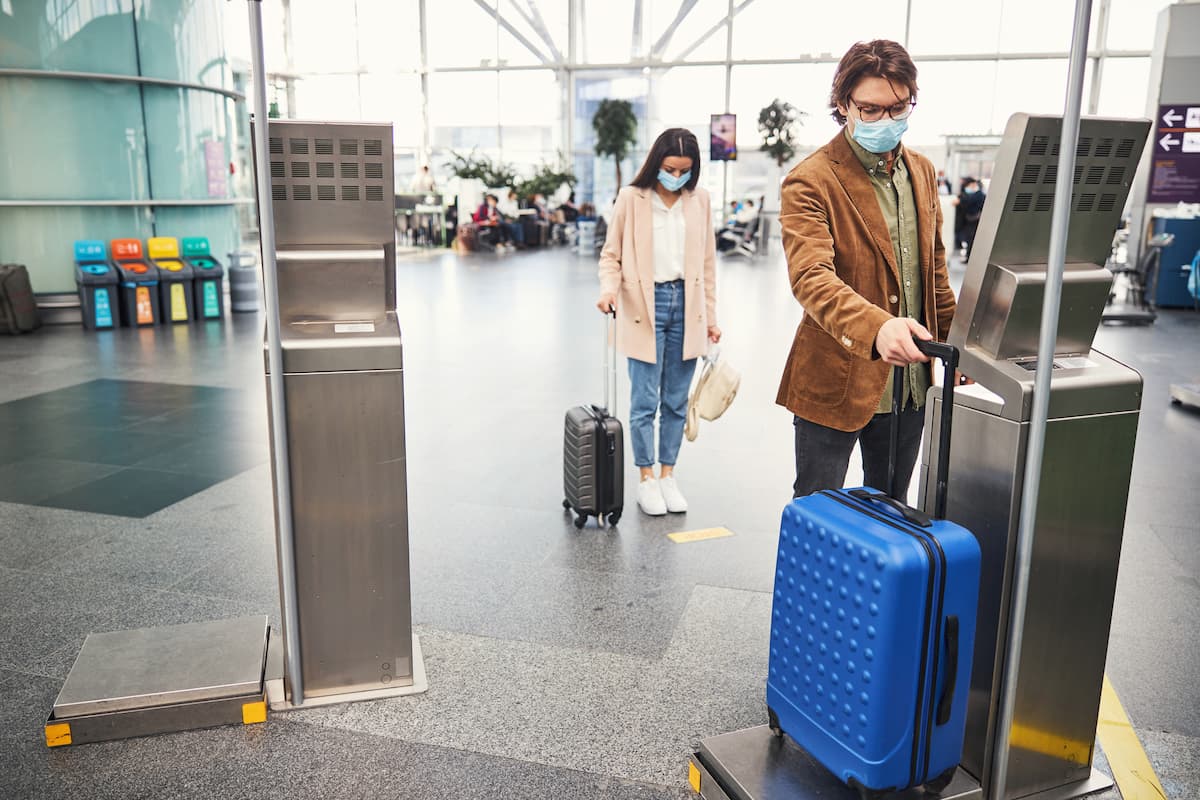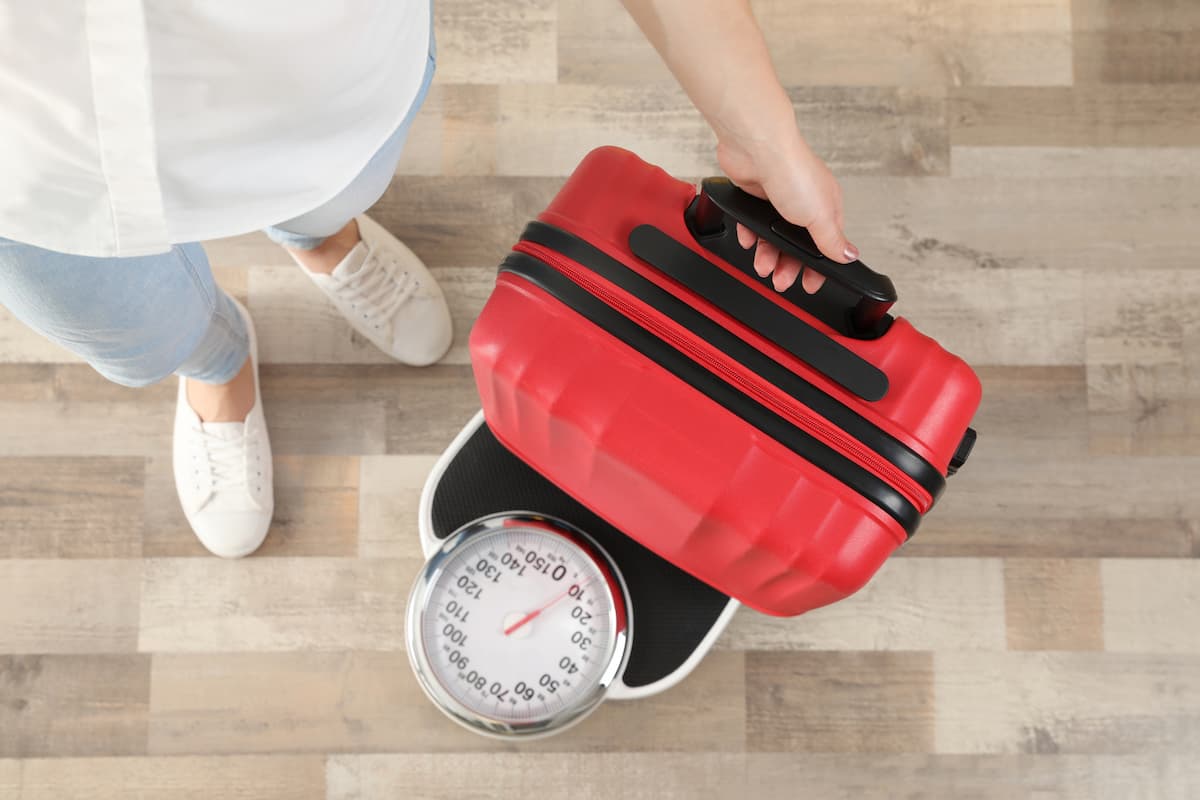How To Weigh Luggage Without A Scale?
All airlines have size and weight restrictions for carry-on and checked luggage, and they aren’t usually forgiving when a bag exceeds the limits.
If your bag is overweight, it can cost an extra $50 to $200 per pound (or kilogram), depending on the airline, the route, and ticket class.
Fortunately, there are a few methods you can use to weigh your bags before heading to the airport without needing a luggage scale:
- Use a regular bathroom scale
- Estimate luggage weight using known items
- Use a makeshift lever and fulcrum
- Weigh your luggage somewhere local.
The following explains the standard baggage allowances for most airlines and four ways to weigh luggage without a scale.
What Is the Usual Weight Limit for Luggage?

Always double-check your airline’s baggage allowances before heading to the airport.
For the most part, the maximum weight for checked luggage is 50 lbs (23 kg) when flying economy; however, some low-cost airlines restrict checked bags to between 40 and 44 lbs (18-20 kg), and business or first-class passengers are usually allowed up to 70 lbs (32 kg).
Most US airlines don’t have weight restrictions for carry-ons, but you must be able to lift your bag into the overhead bin unassisted.
That said, there are a few US carriers with weight limits for carry-on, including:
- Delta Airlines flights from
- Changi International Airport (SIN), Singapore: 15 lbs (7 kg)
- Beijing Capital International Airport (PEK), Beijing, China: 22 lbs (10 kg)
- Pudong International Airport (PVG), Shanghai, China: 22 lbs (10 kg).
- Frontier Airlines: 35 lbs (15.8 kg)
- Hawaiian Airlines: 25 lbs (11 kg).
Also, many international airlines do have weight limits for carry-on, including:
- ANA: 22 lbs (10 kg)
- British Airways: 51 lbs (23 kg)
- EasyJet: 33 lbs (15 kg)
- Ryanair: 22 lbs (10 kg)
- Turkish Airlines: 17 lbs (8 kg).
If you want to weigh your bag before you leave, buy a travel luggage scale or try one of the following methods.
Read Also >> How To Measure Your Luggage For Air Travel
4 Ways to Weigh Luggage Without a Scale

1. Use a Bathroom Scale
If you don’t have a luggage scale, using a regular bathroom scale is the easiest way to determine your bag’s weight.
When your suitcase is small enough (think carry-on sized), you can likely just put it on the scale, get a fairly accurate reading, and adjust accordingly if it’s overweight.
However, you may have to get crafty if you’re trying to fit a full-sized suitcase, duffel bag, or travel backpack on a bathroom scale.
The simplest solution is to weigh yourself while holding the bag.
First, stand on the scale alone and write down your solo weight.
Then pick up your luggage, stand on the scale, and write down the combined weight.
Once you have the two numbers, subtract your weight from the combined weight, and you’ll know how heavy your bag is.
2. Estimate With Known Weights
If you don’t have access to a luggage or bathroom scale, you can try to guestimate the weight of your bags using things around the house.
All you have to do is find an item that weighs about 50 lbs (23 kg), pick it up, and remember how heavy it feels.
After putting the object down, immediately pick up your suitcase and see if it feels the same.
If you’re wondering what weighs around 50 lbs (23 kg), here’s a quick list:
- a 50-inch (127 cm) flat-screen TV
- a standard mini fridge (5 cubic ft or less)
- a twin-sized mattress
- a large bag of dog food
- two cinder blocks
- a male bulldog
- the average 7-year-old.
If your bag feels heavier than any of these, it will likely exceed the airline’s weight limit.
3. Use a Makeshift Lever and Fulcrum
If you can’t get a good feel from picking things up, you can always make a DIY luggage scale using a lever and fulcrum.
For this, you’ll need an assistant, a plank, a pivot (or a fulcrum), and anything with a known weight of around 50 lbs (23 kg).
Essentially, you’re building a seesaw by placing the pivot under the center of the plank.
You’ll be able to determine the weight of your bag by putting it on one end of the seesaw and 50 lbs (23 kg) of things on the other.
If the plank is level, your bag weighs the same as the items. If the suitcase stays on or closer to the floor, it’s overweight.
The plank and the pivot should be made of strong materials that can bear the combined weight of the luggage and items.
If the plank is weak, it’ll snap in half before you’re done adding weight; if the pivot is weak, it’ll be crushed or flattened, defeating its purpose of keeping everything off the ground.
You can use an old door or piece of wood for the plank and a cylindrical item (like a log or full water bottle), a bowling ball, some carefully stacked books or bricks, or a cinder block for the fulcrum.
For the 50 lbs (23 kg) objects, you can use hand weights, barbells, two SUV tires, a 6-gallon (22 L) jug of water, or your 7-year-old, etc.
The trick is keeping the plank centered on the pivot – if it’s off-center, it changes the weight balance, which is why having an extra set of hands helps to pull this off.
Your assistant can help keep the contraption steady as you add the luggage and weighted items.
Also, adding smaller amounts of weight at a time will give more accurate results.
Start by putting your bag on one end, then add items slowly to the other.
Once the plank is balanced, you’ll know how heavy the bag is based on the combined weight of the stuff on the other side (up to 50 lbs/23 kg).
However, if you only have one 50 lbs (23 kg) item to work with, that’s ok too – you’ll just want the plank to balance perfectly or for that side to be closer to the ground.
4. Weigh Your Baggage Somewhere Local
Local hardware stores, health clubs, post offices, and junkyards have scales customers can often use for free.
However, if you aren’t a regular at any of these establishments, you may need to pay or talk to someone before using their stuff as a luggage scale.
Also, if you do take your bag somewhere to be weighed, give yourself time to repack it if your luggage is overweight.
Health Clubs
If you are a gym member, you can ask the staff if you can weigh your bags on one of their fitness scales.
However, these scales might be too small for your luggage, so treat them like a bathroom scale and weigh yourself while holding your bag.
Hardware Stores
Getting permission to weigh your luggage at a hardware store might be difficult, but it’s worth asking if there’s one close by and you’re concerned that your luggage is overweight.
Some stores may even have scales outside, but it’s less common now than it was a few years ago.
Junkyards
Junkyards rely on accurate scales to weigh metal waste and other scraps, so you can count on their scales to be precise.
They are also usually huge, so your luggage will definitely fit.
The only problem with junkyards is they’re often outside of urban areas, so you may only want to consider this option if there’s one near you.
Post Office or Courier Depots
Post offices and courier depots need scales to accurately measure packages and charge shipping fees.
If you’re in a pinch, you can always ask your nearest post office or FedEx location if you can weigh your luggage on one of their scales.
Just note that smaller postal outlets may not have big enough scales, and they may refuse your request if they’re really busy or it’s against company policy.
Doctor’s Offices
Medical offices often have scales to keep track of their patients’ health, so if you have a good relationship with your doctor, you can ask to use theirs to weigh your bags.
Travel Agents
Travel agents work to ensure their clients have a safe and enjoyable trip, and they may have a luggage scale available for customer use.
Hotels
Many hotels have luggage scales available – but if they don’t, they likely have a bathroom scale you can use.
Final Thoughts
Most airlines are strict about baggage allowances, so ensuring your luggage is within size and weight limits will save you time and money when checking in to your flight.
If you don’t have a travel-sized luggage scale, there are a few things you can do to weigh your bags before heading to the airport:
- Use a regular bathroom scale
- Guestimate using known items
- Use a makeshift lever and fulcrum
- Weigh your bags somewhere local.
The standard weight limit for checked baggage is up to 50 lbs (23 kg) but check with your airline directly for their current luggage policies.